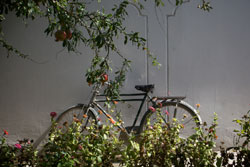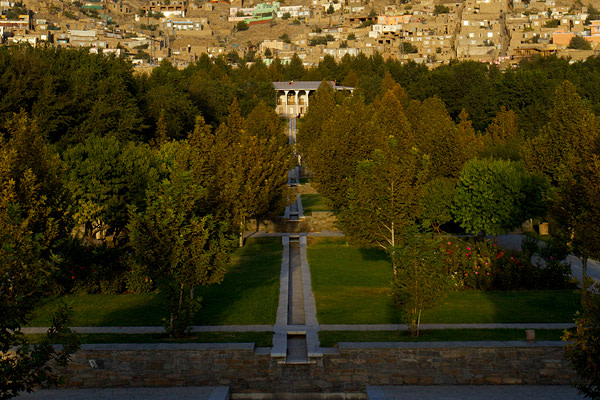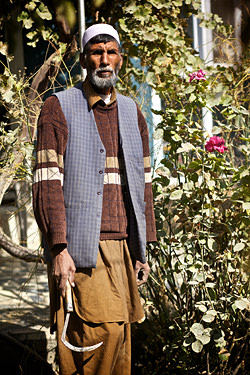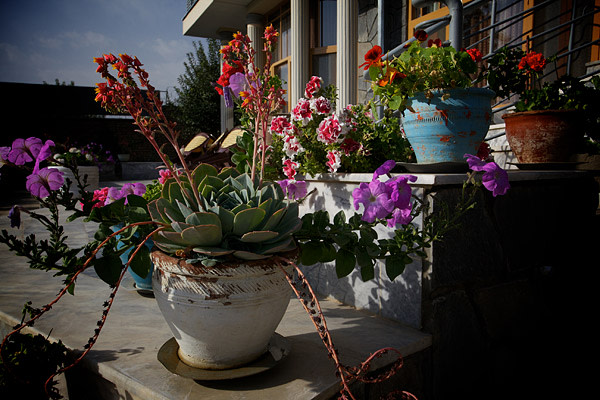Kabul’s hidden gardens offer Afghans haven from war

Simply sign up to the Life & Arts myFT Digest -- delivered directly to your inbox.
Today Kabul is synonymous with war, destruction and security checkpoints. Creating peaceful gardens in the capital of landlocked, war-torn Afghanistan is not easy. But Kabul was once known as a city of gardens. Indeed, behind the razor wire and 10ft walls of private residences, there are still verdant serenities, a world away from the bedlam outside.
“There is something about the climate. It’s a special place and it is little wonder that Afghans love to garden,” says Jolyon Leslie, a South African architect who has lived in Kabul for more than 20 years.
For the Timurids and Mughals marauding through Central Asia in the 1500s, gardens were a respite from the harsh deserts and mountains with their pounding winds and ferocious temperatures. High walls protected them from winds, tall plane trees provided shade, water channels gave refreshment and fruit trees gave sustenance. They were Eden on earth.

The Mughal emperor Babur built his finest garden in Kabul, his favourite city, in 1528 to prove he was at least a marauder with taste. Indeed, he is said to have enjoyed so many long afternoons here, with concubines and fountains of wine, that he chose it as his final resting place, requesting that his tomb be left open to the elements to allow wild flowers to grow around him – which it was, until about 1638, when the emperor Shah Jahan enclosed it.

Time has taken its toll on Babur’s original garden. By 2001, three decades of foreign occupation, unrest, a devastating civil war and iron-fisted Taliban rule, had rendered it non-existent. When restoration on the site, known as Bagh-e-Babur, began in 2002, by the Aga Khan Foundation, architects and designers had almost nothing physical to go on.

“We had an idea how it might have looked from other Mughal gardens, but really we didn’t have a clue,” says Leslie, who was involved in the project. The team relied heavily on 19th-century sketches, early photographs and historical descriptions. While returning these aspects of the garden to their former glory, they also wanted to help revive a fledgling Afghan cultural identity and develop a modern space in which families could relax and socialise.

The design, however, was the least of their worries. “There were mines and unexploded weapons lodged in the mud walls and piles of rubble,” says Leslie. “Clearing them took time.”
Kabul sits at an altitude of 1,800 metres and in winter the temperature can plummet to -20C, but it is the heat that most worries Engineer Abdul Latif Kohistani, the resident horticulturalist also involved in the restoration. In the summer, when temperatures can soar to more than 40C, he employs an additional 11 gardeners in addition to his permanent staff of 13 to irrigate, lime, fertilise and protect more than 5,500 plants and trees.

Another concern for Latif is the city’s poor air. He points to the browning walnut leaves. “Pollution poison,” he says. Each tree is like a child to me and I hate to see them suffer.” Babur’s gardens are popular: each year they attract more than 300,000 visitors, partly because most Kabuli residents cannot afford the luxury of their own patch of land in the city.

Leslie’s own garden, in the upmarket area of Qala-e-Fatullah, would originally have been part of an orchard on the outskirts of a smaller Kabul. “Many of my neighbours concreted their gardens to make room for cars or outhouses. I’m fortunate to still have old orchard fruit trees, as well as a Judas tree and a Russian olive (Elaeagnus angustifolia), which the Afghans abhor, of course.” But he admits that keeping them alive is a challenge because the soil is affected by the open sewers just outside his compound.
He also has beds of Michaelmas daisies growing among hardy, indigenous and heavily scented roses of pink and vermilion red, as well as soft pink dog roses and yellow hybrids. “Afghans certainly know how to cultivate roses and love their ornamentation and scent,” he says. It is a sentiment shared by interior designer Rahim Walizada. He starts each day with a walk through 6ft-tall colonnades of fragrant, soft yellow roses in his garden. “It’s hard to find beauty in this city, but it’s important to have a space in which you can find peace,” he says.

In his garden can be found a slice of peaceful, rural Afghanistan. “We used to run and play here when we were little and my family memories are only happy,” says Walizada.
However, when he returned to his homeland after the fall of the Taliban, in 2001, the memories were shattered. The garden had been a battleground and the walls were riddled with bullets. The Walizadas set to work clearing the land, turning the soil, planting trees and redefining the spaces for shade. “You don’t feel like you are in the middle of the city when you come here. The garden was my father’s passion and this is his legacy,” he says.

A mile away stands Darul Aman palace. Darul Aman, meaning “abode of peace”, was built by King Amanullah and once boasted large western-style gardens which were popular in the early 1920s when it was constructed. Fires and fighting have done little to relieve the palace of its stubborn majesty, but the gardens are no more. Or nearly. Mohammad Kabir began reviving the palace’s courtyard earlier this year. Originally employed to work on the vegetable garden belonging to the Afghan soldiers stationed there, he decided to make them a mini-pleasure garden. The result is a confusing riot of colour against the crumbling palace battlements. But he is proud. “I brought whatever seeds I had at home and the soldiers helped plant them,” he says, leaning against a spent rocket-propelled grenade shell. “Everything you see is from paradise. I’m in paradise when I’m here.” Kabir claims to be 105 years old and remembers working as a gardener when the palace was built. He also remembers the elephants and donkeys that were used to transport trees. Whether this is a tale of fancy or not, he puts his youthful complexion and strength down to a century of gardening. “I’m a poor man and can live without food,” he says. “But I can’t live without seeing leaves and flowers.”
Sayed Yahoob has been less fortunate. “My family has always lived here and this garden used to be filled with roses, but now there’s not much I can do,” he says of his home on the outskirts of Kabul. As head gardener at an international cultural organisation, it is not his lack of horticultural knowledge holding him back. Despite living on the edge of Lake Qargha, drought and the spiralling price of water has meant that a productive garden is a dream for someone in his situation. This is hard, he says, given that he comes from a long line of men who lived off the land. “Gardens are not just about beauty, they are about survival,” he says.

On the other side of Lake Qargha, Dr Zabiullah Mojadidi has a little more leeway when it comes to irrigation. Often followed by extremist factions and the ISI, the Pakistani intelligence agency, his past as a resistance fighter and former governor of Kabul has meant that he has had to move out of the city to be near his father, a former Afghan president. The lake serves as buffer on one side, while the well-manned checkpoints, blast walls and fortresslike entrance on the other keep away would-be attackers.
Being so far from the centre suits him and his garden well. “You don’t get a face full of dust when you smell a flower,” he says.
Although he spent almost 20 years living in America, he says the design of the garden is thoroughly Afghan, with its water channels and clearly defined terraces and areas of shade. His wife brought seeds in from Virginia and, at the bottom of the garden, there is a vegetable patch of courgettes, squashes, spinach, cauliflower, carrots and tomatoes.

While Kabul university is training a new generation of agricultural gardeners, neither Engineer Latif nor Sayed Yahoob believe young people have the proper knowledge to keep up the work of their forefathers. “They don’t believe in hard work,” says Yahoob. In war-torn Afghanistan, this would be a great loss. As the young soldiers stationed at Darul Aman palace say: “Green is happiness, green is peace: Who doesn’t like that?”
Comments